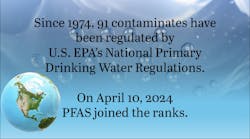Blamed for algae blooms yet heralded for its nutrient properties, phosphorous in wastewater is now being taken seriously by the water industry.
Commercial, large scale companies are now setting up operations with utilities (see WWi story) yet researchers at Aalto University in Finland have developed a method which they claim can take place at the same time as traditional wastewater treatment.
Trialled to reduce the amount of phosphorus in the wastewater of a pulp mill, the method is called simultaneous precipitation using iron sulphate. A separate treatment stage is not required, as the precipitation takes place simultaneously with the actual biological wastewater treatment.
Iron sulphate is added to the wastewater prior to the biological wastewater treatment process and the phosphorus dissolved into the water is precipitated with the biomass at the treatment plant. Finally, the phosphorus is removed from the plant with the sludge.
In Finland, sludge is generally burned, in which case the phosphorus would end up in the ashes and would thus be reusable in the form of fertilizers, for example.
Elsewhere, perceptions of wastewater have been changed from a substance to be disposed of to a valuable resource in the US and Canada (see WWi story).
Researcher Sakari Toivakainen, said: “At best, the amount of phosphorus in the wastewater was reduced by more than 80%, when the amount of iron fed into the process was 10 milligrams per litre.”
Initially, the research was carried out in the laboratories of Otaniemi and at the plant using pilot equipment. Iron precipitation was then tested at the wastewater treatment section of a pulp mill.
Professor Olli Dahl from the University said: “With the help of the studied simultaneous precipitation method, it is possible to completely avoid additional stages of wastewater treatment, reduce the amount of solid waste and save energy. Simultaneous precipitation produces hundreds of thousands of euros worth of savings in operating costs, as energy consumption and the need for additional chemicals is reduced.”
###


